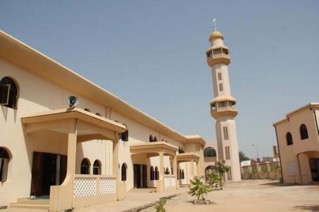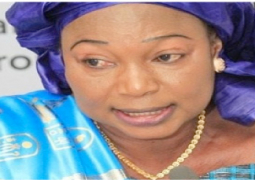
Its regal minaret stands tall and proud at 33 meters and reaches places beyond the core of Muslims when it’s occupied by a Muezzin soulfully calling out for prayers. Standing on 2000 square feet of land with a capacity to hold about 3000 worshippers, the grand Pipeline Mosque has become a divine cocoon of worship and sustenance for the Muslim community at large.
In the bouts of 1973, the beginning of rapid urbanisation, when the Pipeline area came into being and became home to an overwhelming number of Muslims, the lack or availability of a mosque propelled some of its early settlers, who were linked by virtue of their Banjul connection and profound love for religion, to pull their weight and build a place of worship for their community. The late Alhaji Daddy Jobe, founder and first president of the mosque committee, filed for a piece of land in 1985 and was successfully allocated it in 1986. With the assistance of Mahtarr Jobe, an exceptional Gambian architect, the design for the structure of the mosque was drawn, and construction was soon on its way.
Four years down the road, with the help of funds mobilised by the committee, the mosque was but a small building sitting in the middle of the land with a capacity of no more than 300 worshippers. This heavily appreciated miracle had its foundation stone laid by the late Ma Ansu Nyang of Sirmang and was officially inaugurated Friday, February 28th, 1990, through a grand sermon (Khutba) performed by the late Sering Alieu Kah, Father of Imam Cherno Kah, witnessed by a broad congregation, with its first imam chosen being the late Imam Mass Jah, a renowned Islamic scholar and one of the key committee members of the mosque.
A Gamou followed suit in the evening in celebration and to render thanks to Allah for enabling the construction of the mosque to see its completion. This Gamou continues, to this day, as an annual event to commemorate the birth of the holy Prophet Muhammad PBUH and also stands to be a profound pillar for the outpouring of local funds that helps heavily with the upkeep of the mosque.
The Pipeline Mosque was cruising on the backs of two primary committees at the time, the female committee called ‘Dairahtul Amrulbil Mahr’ led by Ajaratou Amie Jallow, Aji Amie Saine, Aji Sailey Njie, Aji Nya Nya Gaye, Ya Jaja Jallow, Mary Gillen, and Aji Koura Ndow among others, and the male committee led by Imam Mass Jah, Mahtarr Jobe, Alhaji Daddy Jobe, Alhaji Ebou Manneh, Ahmad Tijan Wadda, and Badou Faye among others. These two committees pioneered most of the activities members of the mosque still religiously uphold to this day. Activities like the annual Gamou, giving out Ndogou during Ramadan, and offering fresh meat to the needy during Tobaski.
A decade after the first mosque was built, there was an outpour of residents in Pipeline, it was becoming home to businesses and educational institutions, thus the capacity of the mosque was becoming inadequate to accommodate the practicing Muslims that came with the increasing population. People were laying praying mats (sajjadas) outside the mosque for congregational prayers. The mosque committee under the command of the late Alhaji Abou Dandeh Njie, then embarked on a new architectural journey to expand it, with Mahtarr Jobe (managing director of Gam Tech) as the lead architect responsible for facilitating the structures within the mosque. This decision goes on to landmark Pipeline Mosque as the biggest, most modern mosque in the Gambia. The elegant interior design and the colossal Qubba dressed in Egyptian blue and desert gold calligraphy of Quranic scriptures prove to be a testament to the brilliance of our local craftsmen who, with the help of local funds, were able to bring such an architectural masterpiece to life.
The mosque did not receive a second inauguration and its use during construction continued in a phased-out manner till completion under its first imam who passed away in 2009. Imam Momodou Njie, who was an Arabic scholar, was chosen to succeed Imam Mass Jah and he stayed in position until 2015 when he, unfortunately, passed away. The third Imam of the Pipeline Mosque is Imam Fallou Joof who was the first deputy Imam to Imam Mass Jah. He was appointed the position in 2016 and remains the current serving Imam.
The grand Pipeline Mosque, known for its dazzling beauty and charitable acts, saw life as a result of dedicated people from all social constructs of life who came together for their love for Islam and poured it into a home for Muslims. Much like the Taj Mahal, the pipeline mosque stands to be an architectural masterpiece that goes beyond a place of worship, such a magnificent edifice will stand the test of time, and when a day comes when its wondrous nature is talked about, we must devote our thanks and prayers to the late and living pioneers who fought with everything they had and did their community proud.




